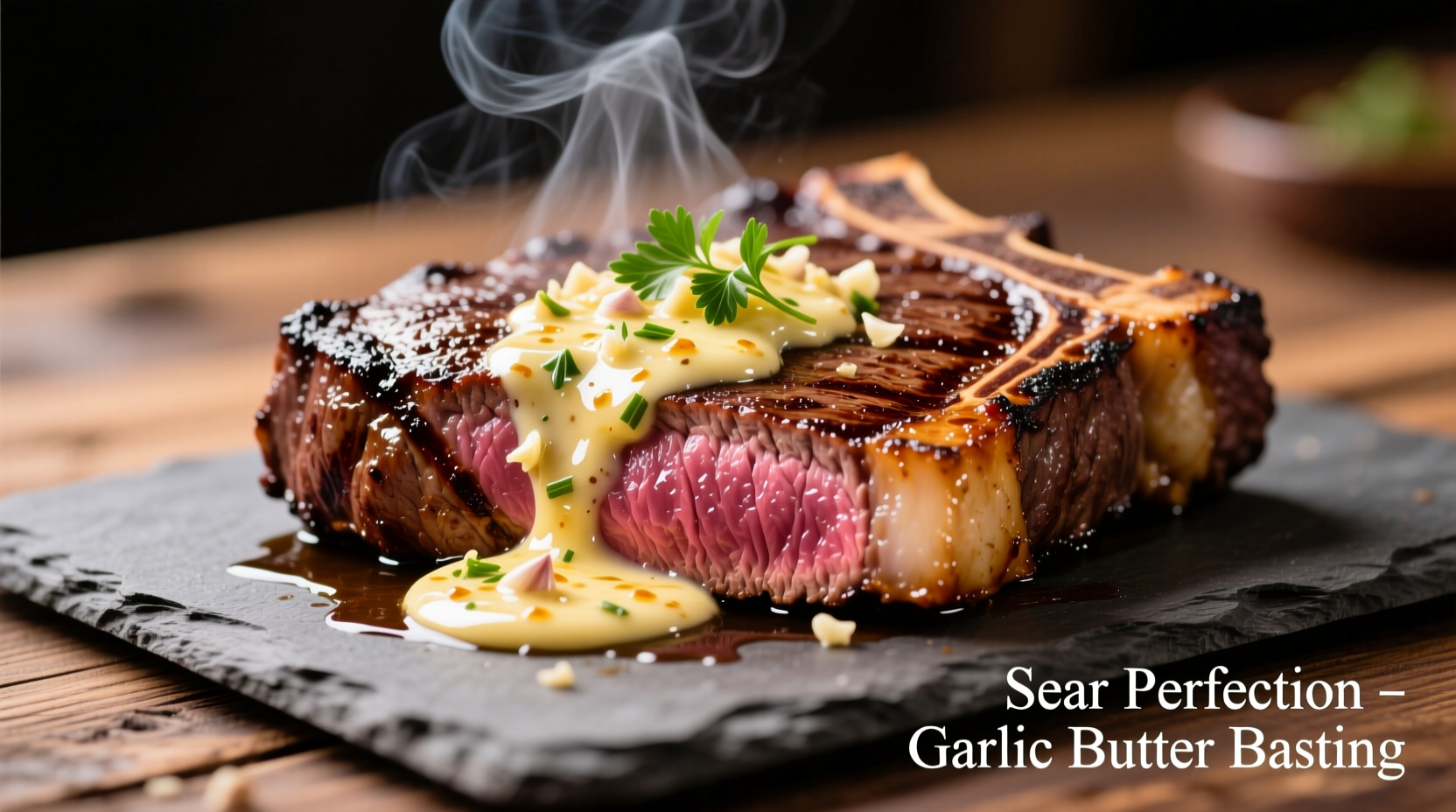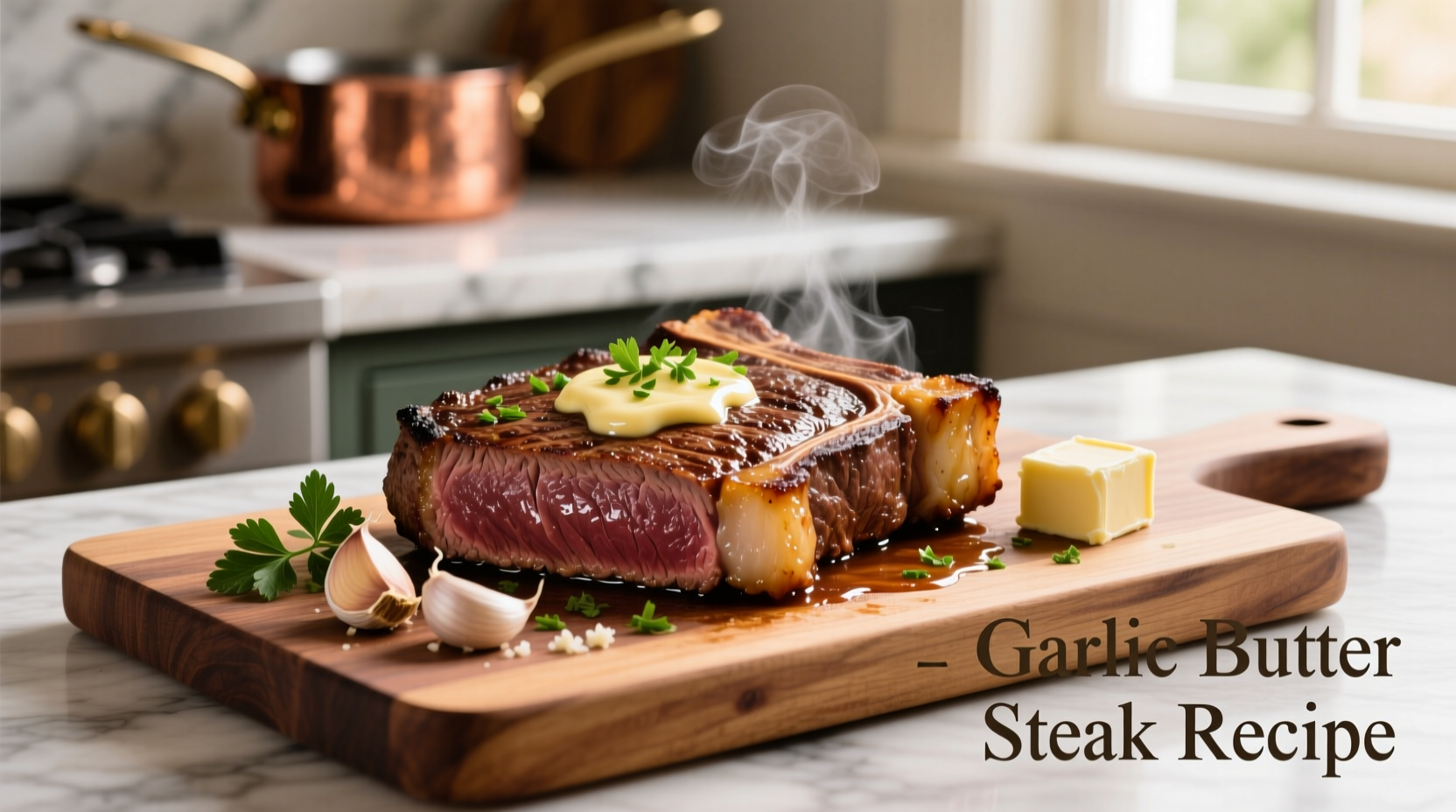The Science Behind Perfect Garlic Butter Steak
Understanding the chemistry of steak preparation transforms your cooking results. When steak hits a hot surface above 300°F (149°C), the Maillard reaction creates complex flavor compounds through amino acid and sugar interactions. This non-enzymatic browning process, explained by the American Chemical Society, develops the rich, savory crust essential for exceptional steak.
Garlic's flavor compounds change dramatically with heat. Raw garlic contains allicin, which breaks down into milder compounds when cooked. Adding garlic to butter after searing prevents bitterness while allowing its aromatic compounds to infuse the fat, creating a balanced sauce that complements rather than overwhelms the meat.
Essential Ingredients Checklist
Selecting quality ingredients makes the difference between good and exceptional steak:
| Ingredient | Critical Selection Criteria | Why It Matters |
|---|---|---|
| Steak (1-1.5" thick) | Ribeye, NY Strip, or Filet Mignon with visible marbling | Fat content ensures juiciness and carries flavor compounds |
| Butter | Unsalted, European-style (82%+ butterfat) | Higher fat content prevents sauce from breaking during basting |
| Garlic | Firm bulbs with tight skins, no green sprouts | Fresh garlic provides optimal flavor without bitterness |
| Cooking Fat | Avocado oil or ghee (smoke point >400°F/204°C) | Prevents burning during high-heat searing |
Step-by-Step Cooking Process
Preparation Phase (15 minutes)
Remove steak from refrigerator 30-60 minutes before cooking to reach room temperature. Pat completely dry with paper towels—moisture is the enemy of proper searing. Season generously with kosher salt (1 tsp per pound) and freshly ground black pepper. The salt draws out surface moisture while enhancing flavor penetration.
Searing Technique (8-10 minutes)
Preheat heavy skillet (cast iron or carbon steel) over medium-high heat for 5 minutes until drop of water sizzles violently. Add 1 tbsp high-smoke-point oil, then place steak in skillet away from you to prevent oil splatter. Do not move the steak for 3-4 minutes to develop proper crust. Flip once when steak releases naturally from the pan.
During the last 2 minutes of cooking, add 3 tbsp butter, 3 crushed garlic cloves, and fresh herbs to the pan. Tilt skillet and spoon melted butter continuously over the steak for even flavor distribution and temperature control.

Temperature Control & Resting (5-10 minutes)
Use an instant-read thermometer to check internal temperature against USDA guidelines:
- Rare: 120-125°F (49-52°C) - remove at 115°F (46°C)
- Medium-rare: 130-135°F (54-57°C) - remove at 125°F (52°C)
- Medium: 140-145°F (60-63°C) - remove at 135°F (57°C)
Transfer steak to cutting board and rest for 5-10 minutes (longer for thicker cuts). This allows juices to redistribute—cutting too soon releases up to 30% of the moisture according to meat science research from the American Meat Science Association.
Troubleshooting Common Issues
Rescuing Broken Butter Sauce
If your garlic butter separates, immediately remove from heat and whisk in 1 tsp cold water. The water helps re-emulsify the sauce by creating a new fat-water interface. For persistent separation, start with a fresh tbsp of cold butter while whisking vigorously.
Fixing Overcooked Steak
Accidentally cooked past desired temperature? Slice thinly against the grain and serve with extra garlic butter sauce. The thinner slices cool faster, preserving some juiciness, while the sauce compensates for dryness. This technique works particularly well for flank or skirt steak variations.
Flavor Variations for Different Preferences
Herb-Infused Butter Options
Enhance your garlic butter with these professional variations:
- Classic French: 2 tbsp chopped parsley + 1 tsp thyme
- Smoky Depth: 1/2 tsp smoked paprika + 1 minced shallot
- Spicy Kick: 1/4 tsp red pepper flakes + 1 tsp lemon zest
- Dairy-Free: Substitute butter with 3 tbsp olive oil + 1 tbsp nutritional yeast
Cooking Method Adaptations
This garlic butter technique works across cooking methods:
- Grill: Sear over direct heat, then move to indirect heat for finishing with butter basting
- Oven Finish: Sear in skillet, then transfer to 400°F (204°C) oven until desired temperature
- Sous Vide: Cook to precise temperature first, then sear briefly with garlic butter
Serving Suggestions & Pairings
Serve your garlic butter steak with these complementary pairings:
- Classic Pairing: Creamy mashed potatoes and roasted asparagus
- Light Option: Arugula salad with lemon vinaigrette to cut richness
- Wine Match: Cabernet Sauvignon (bold cuts) or Pinot Noir (tender cuts)
- Leftover Idea: Thinly sliced steak in fajitas or on top of salad
Frequently Asked Questions
Can I use salted butter for garlic butter steak?
Yes, but reduce added salt in seasoning. Salted butter contains about 1.5% salt, which can make the final dish overly salty when combined with pre-seasoning. Unsalted butter gives you precise control over sodium levels, especially important for thicker cuts that require longer cooking.
Why does my garlic burn during cooking?
Garlic burns at temperatures above 375°F (190°C). Add it to the butter during the last 2-3 minutes of cooking, after the steak has developed its crust. Whole cloves are more forgiving than minced garlic, which has greater surface area and burns faster. For stronger garlic flavor without bitterness, infuse the cooking oil with crushed garlic before adding the steak.
How do I prevent steak from sticking to the pan?
Ensure both pan and steak are properly heated before contact. The pan should be hot enough that a drop of water sizzles violently. Pat steak completely dry—any surface moisture creates steam that prevents proper searing. Don't move the steak until it naturally releases from the pan surface, typically after 3-4 minutes of contact. Proper preheating and dry surface create the Maillard reaction that naturally prevents sticking.
Can I make this recipe with frozen steak?
For best results, always thaw steak completely before cooking. Frozen steak releases excess moisture during cooking, preventing proper searing and resulting in gray, boiled-looking meat. If you must use frozen steak, increase initial cooking time by 50% and expect less consistent results. The USDA recommends thawing meat in the refrigerator for 24-48 hours depending on thickness for optimal food safety and quality.











 浙公网安备
33010002000092号
浙公网安备
33010002000092号 浙B2-20120091-4
浙B2-20120091-4